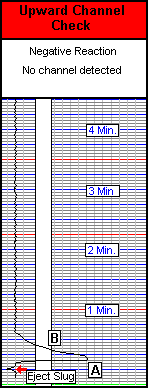

Upward Channel Checks are run to determine if there is communication going up behind the casing.
Upward Channel checks are recorded on time drive. The only reference to depth are the notes the logger writes during the test. Each division on the API grid is equal to 3 seconds.
On our example well, we have a top perf at 5700 feet. Our ejector port is 60 inches above the detector. We will set the detector at 5700’ and eject a slug while recording the detector on time drive.
In the first example (Negative Reaction):
In this particular case we wait 4 to 5 minutes and see no reaction.
In the second example (Positive Channel):

No material ever reaches us at 5660’. We now believe the channel to end between 5670’ and 5660’. However, we need to confirm and define the channel with a drag run on depth drive.

Drag Run
The purpose of making a drag run on depth drive has a two fold purpose. One is to see where the exact top of the channel is and the other is to see if any material passed outside the detector’s radius of investigation.
Most people don’t realize just how shallow a detector reads into the formation. On average, a scintillation detector will see a mild radioactive source only 9 to 16 inches away from the tool. It’s not hard to imagine a channel path deviating in and out of that range. Although rare, it is possible for the radioactive material to go undetected at one of the timed stationary settings.
Back to our example well. You can see trace readings of the radioactive material we followed up on the channel check. However, the drag run indicates that material did go by us undetected at the 5660’ stationary reading. Material (green) has traveled up to 5624’. I must emphasize that this is not a regular occurrence. But, it can happen and you can not consider a channel check without a drag run to be conclusive.
Most drag runs look like this example up to 5662’ (red) and then go back to a base gamma ray reading. This would confirm the expected channel up to 5662’.
Injection Profile Page
Cardinal Welcome Page
